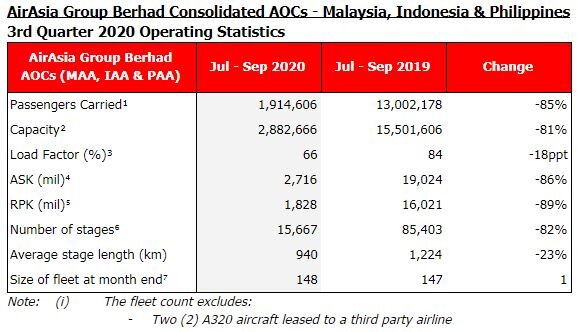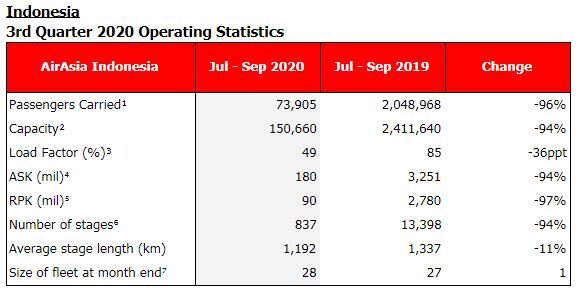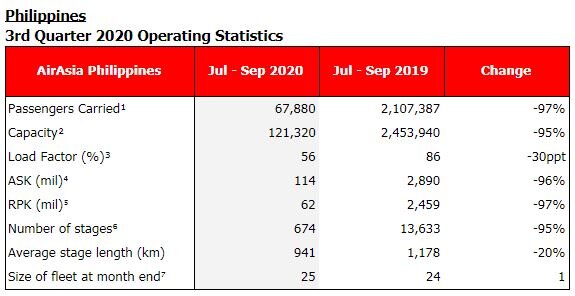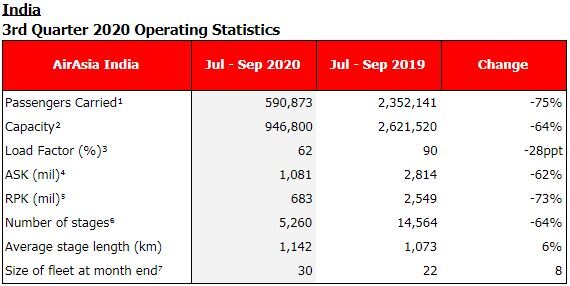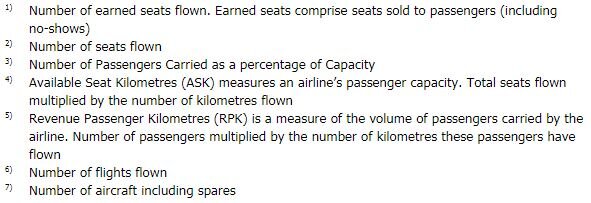AirAsia Group Berhad continued its recovery momentum into 3Q2020 as key operational metrics improved in September as compared to July, including a 36% increase in passengers carried by AirAsia Malaysia, 79% increase in passengers carried by AirAsia India, and an increase of 65% of passengers carried by AirAsia Thailand. Load factor for the Group increased 7 percentage points (“ppts”) in September as compared to July 2020. These improvements highlight a strong upward rebound trend for air travel demand across key markets for the Group.
AirAsia Malaysia operated 52% of its domestic capacity in September, in comparison to 40% in July 2020 as travel demand has been on an upward trajectory since 2Q with the easing of restrictions on interstate travel. AirAsia Malaysia achieved a 68% load factor while carrying close to 1.8 million passengers during the quarter. While capacity has been reduced in October 2020 given the conditional movement control order by the government, AirAsia Malaysia is striving to recover to 60% of its pre-Covid domestic capacity by 4Q.
AirAsia Indonesia posted a load factor of 49% for 3Q2020, down by 36 ppts as compared to the same period last year. AirAsia Indonesia’s operations have gradually picked up since the resumption of services on 19 June but have remained below pre-Covid levels. While AirAsia Indonesia carried only 4% of passengers in 3Q2020 at 73,905, the number of passengers carried improved by 18 times quarter-on-quarter as we resumed more flights in line with the easing of travel restrictions. A month-to-month breakdown showed an increase of 31% in capacity being operated and an improvement in the number of passengers carried by 60% in September in comparison to July. AirAsia Indonesia operated 12 routes during the quarter, including 5 international routes namely Kuala Lumpur-Jakarta, Surabaya-Kuala Lumpur, Kualanamu-Kuala Lumpur, Penang-Kualanamu and Kuala Lumpur-Lombok. AirAsia Indonesia also operated 20 charter flights with a total of 5 aircraft being deployed for the quarter. AirAsia Indonesia is expected to ramp up to 45% of its pre-Covid domestic capacity in 4Q.
While AirAsia Philippines operated only 5% of last year’s capacity in the third quarter, passenger numbers more than doubled quarter-on-quarter.
AirAsia Thailand demonstrated a strong rebound in operations in tandem with solid domestic demand. In September, AirAsia Thailand operated 96% of pre-Covid domestic capacity, as compared to 59% in July 2020. During the quarter, AirAsia Thailand carried more than 1.8 million passengers, recording a solid load factor of 65%. In September, AirAsia Thailand seized the opportunity to capture a new customer base, including additional cargo services, by launching a new operating hub at Suvarnabhumi Airport (“BKK”). As a result, AirAsia Thailand maintained the largest market share in Thailand. We are aiming for AirAsia Thailand to operate more than pre-Covid domestic capacity in 4Q.
AirAsia India’s performance during the quarter was commendable with 36% of capacity being operated in comparison to 3Q2019. On a month-to-month basis, in September AirAsia India operated 46% of last year’s capacity, reflecting a 19 ppts increase from 27% in July 2020. Load factor held strong at 62% in 3Q2020, as AirAsia India carried 590,873 passengers, equalling 25% of last year’s 3Q passengers. The Group is optimistic with AirAsia India’s performance and is looking at domestic capacity recovering to 65% in 4Q.
Recommended for you...


